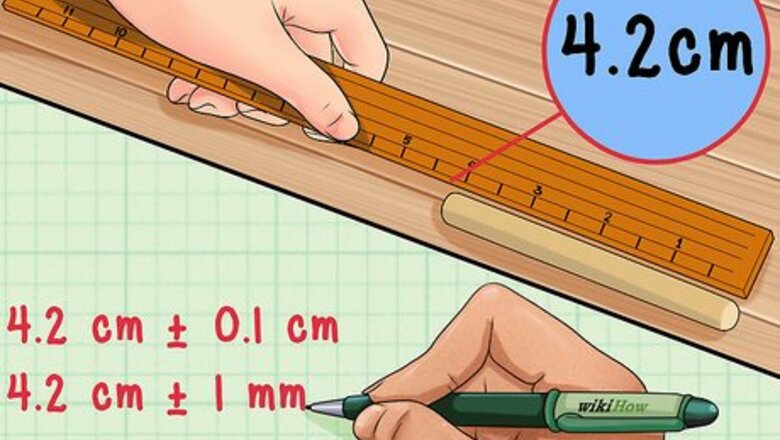
views
Learn the Basics
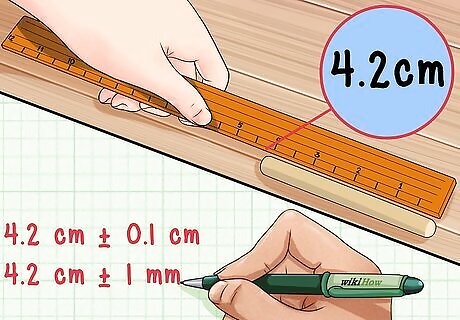
State uncertainty in its proper form. Let's say you're measuring a stick that falls near 4.2 cm, give or take one millimeter. This means that you know the stick falls almost on 4.2 cm, but that it could actually be just a bit smaller or larger than that measurement, with the error of one millimeter. State the uncertainty like this: 4.2 cm ± 0.1 cm. You can also rewrite this as 4.2 cm ± 1 mm, since 0.1 cm = 1 mm.
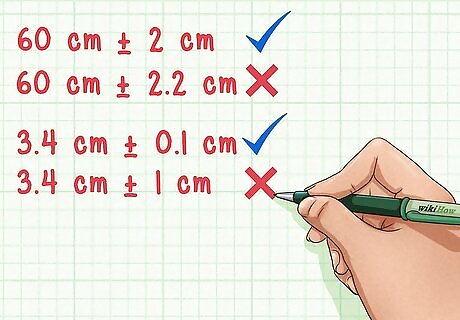
Always round the experimental measurement to the same decimal place as the uncertainty. Measurements that involve a calculation of uncertainty are typically rounded to one or two significant digits. The most important point is that you should round your experimental measurement to the same decimal place as the uncertainty to keep your measurements consistent. If your experimental measurement is 60 cm, then your uncertainty calculation should be rounded to a whole number as well. For example, the uncertainty for this measurement can be 60 cm ± 2 cm, but not 60 cm ± 2.2 cm. If your experimental measurement is 3.4 cm, then your uncertainty calculation should be rounded to .1 cm. For example, the uncertainty for this measurement can be 3.4 cm ± .1 cm, but not 3.4 cm ± 1 cm.

Calculate uncertainty from a single measurement. Let's say you're measuring the diameter of a round ball with a ruler. This is tricky because it'll be difficult to say exactly where the outer edges of the ball line up with the ruler since they are curved, not straight. Let's say the ruler can find the measurement to the nearest .1 cm -- this does not mean that you can measure the diameter to this level of precision. Study the edges of the ball and the ruler to get a sense of how reliably you can measure its diameter. In a standard ruler, the markings at .5 cm show up clearly -- but let's say you can get a little bit closer than that. If it looks like you can get about within .3 cm of an accurate measurement, then your uncertainty is .3 cm. Now, measure the diameter of the ball. Let's say you get about 7.6 cm. Just state the estimated measurement along with the uncertainty. The diameter of the ball is 7.6 cm ± .3 cm.
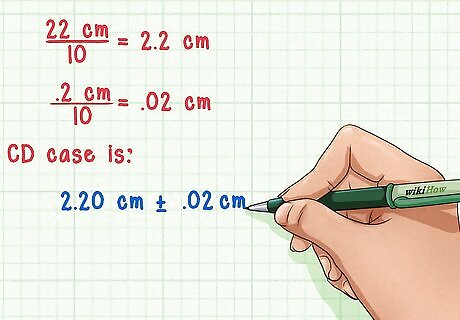
Calculate uncertainty of a single measurement of multiple objects. Let's say you're measuring a stack of 10 CD cases that are all the same length. Let's say you want to find the measurement of the thickness of just one CD case. This measurement will be so small that your percentage of uncertainty will be a bit high. But when you measure 10 CD cases stacked together, you can just divide the result and its uncertainty by the number of CD cases to find the thickness of one CD case. Let's say that you can't get much closer than to .2 cm of measurements by using a ruler. So, your uncertainty is ± .2 cm. Let's say you measured that all of the CD cases stacked together are of a thickness of 22 cm. Now, just divide the measurement and uncertainty by 10, the number of CD cases. 22 cm/10 = 2.2 cm and .2 cm/10 = .02 cm. This means that the thickness of one CD case is 2.20 cm ± .02 cm.

Take your measurements multiple times. To increase the certainty of your measurements, whether you're measuring the length of on object or the amount of time it takes for an object to cross a certain distance, you'll be increasing your chances of getting an accurate measurement if you take several measurements. Finding the average of your multiple measurements will help you get a more accurate picture of the measurement while calculating the uncertainty.
Calculate the Uncertainty of Multiple Measurements
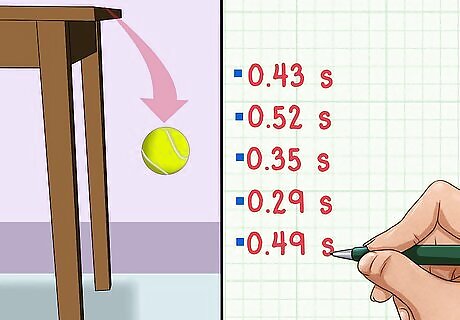
Take several measurements. Let's say you want to calculate how long it takes a ball to drop to the floor from the height of a table. To get the best results, you'll have to measure the ball falling off the table top at least a few times -- let's say five. Then, you'll have to find the average of the five measured times and then add or subtract the standard deviation from that number to get the best results. Let's say you measured the five following times: 0.43 s, 0.52 s, 0.35 s, 0.29 s, and 0.49 s.
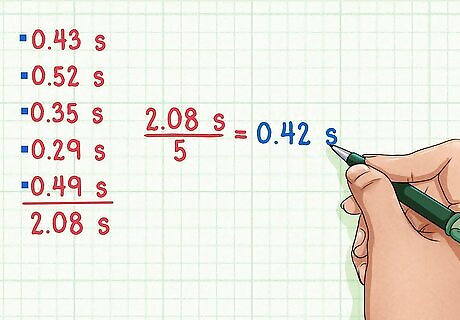
Find the average of the measurements. Now, find the average by adding up the five different measurements and dividing the result by 5, the amount of measurements. 0.43 s + 0.52 s + 0.35 s + 0.29 s + 0.49 s = 2.08 s. Now, divide 2.08 by 5. 2.08/5 = 0.42 s. The average time is 0.42 s.
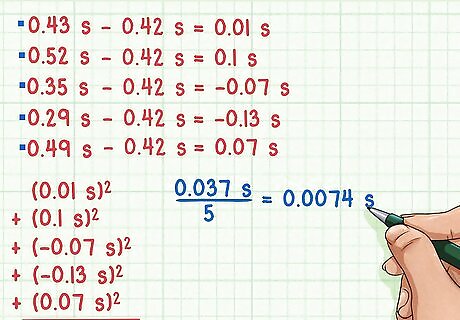
Find the variance of these measurements. To do this, first, find the difference between each of the five measurements and the average. To do this, just subtract the measurement from 0.42 s. Here are the five differences: 0.43 s - .42 s = 0.01 s 0.52 s - 0.42 s = 0.1 s 0.35 s - 0.42 s = -0.07 s 0.29 s - 0.42 s = -0.13 s 0.49 s - 0.42 s = 0.07 s Now, add up the squares of these differences: (0.01 s) + (0.1 s) + (-0.07 s) + (-0.13 s) + (0.07 s) = 0.037 s. Find the average of these added squares by dividing the result by 5. 0.037 s/5 = 0.0074 s.
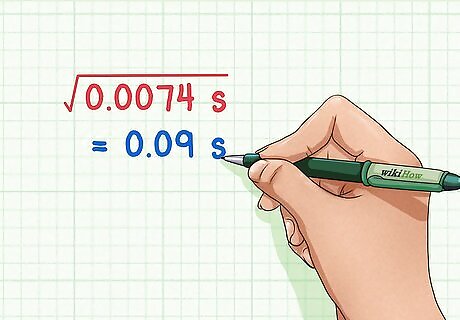
Find the standard deviation. To find the standard deviation, simply find the square root of the variance. The square root of 0.0074 s = 0.09 s, so the standard deviation is 0.09 s.
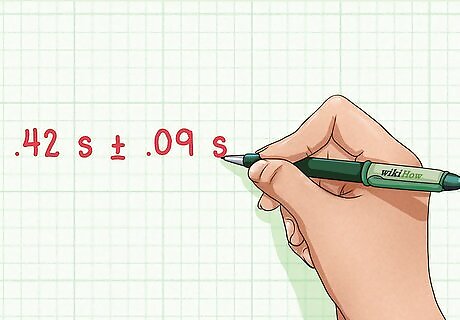
State the final measurement. To do this, simply state the average of the measurements along with the added and subtracted standard deviation. Since the average of the measurements is .42 s and the standard deviation is .09 s, the final measurement is .42 s ± .09 s.
Perform Arithmetic Operations with Uncertain Measurements
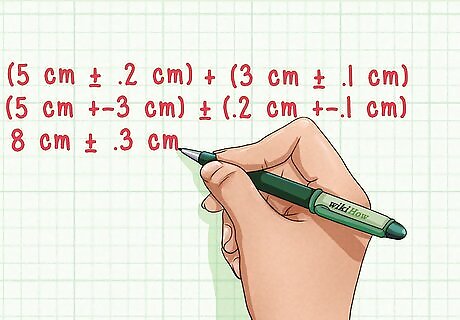
Add uncertain measurements. To add uncertain measurements, simply add the measurements and add their uncertainties: (5 cm ± .2 cm) + (3 cm ± .1 cm) = (5 cm + 3 cm) ± (.2 cm +. 1 cm) = 8 cm ± .3 cm

Subtract uncertain measurements. To subtract uncertain measurements, simply subtract the measurements while still adding their uncertainties: (10 cm ± .4 cm) - (3 cm ± .2 cm) = (10 cm - 3 cm) ± (.4 cm +. 2 cm) = 7 cm ± .6 cm
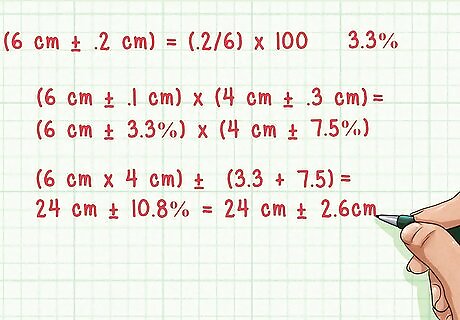
Multiply uncertain measurements. To multiply uncertain measurements, simply multiply the measurements while adding their RELATIVE uncertainties (as a percentage): Calculating uncertainties with multiplication does not work with absolute values (like we had in addition and subtraction), but with relative ones. You get the relative uncertainty by dividing the absolute uncertainty with a measured value and multiplying by 100 to get percentage. For example: (6 cm ± .2 cm) = (.2 / 6) x 100 and add a % sign. That is 3.3 % Therefore: (6 cm ± .2 cm) x (4 cm ± .3 cm) = (6 cm ± 3.3% ) x (4 cm ± 7.5%) (6 cm x 4 cm) ± (3.3 + 7.5) = 24 cm ± 10.8 % = 24 cm ± 2.6 cm
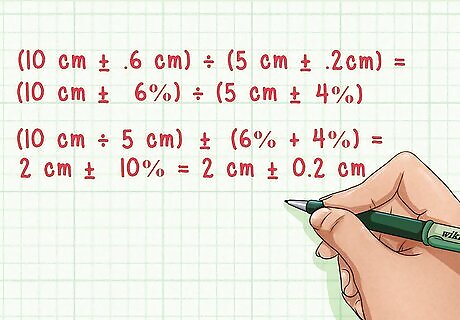
Divide uncertain measurements. To divide uncertain measurements, simply divide the measurements while adding their RELATIVE uncertainties:The process is the same as in multiplication! (10 cm ± .6 cm) ÷ (5 cm ± .2 cm) = (10 cm ± 6%) ÷ (5 cm ± 4%) (10 cm ÷ 5 cm) ± (6% + 4%) = 2 cm ± 10% = 2 cm ± 0.2 cm
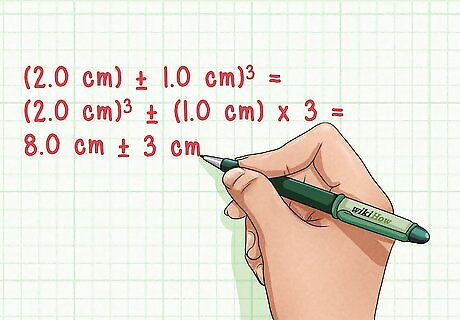
Increase an uncertain measurement exponentially. To increase an uncertain measurement exponentially, simply raise the measurement to the designated power, and then multiply the relative uncertainty by that power: (2.0 cm ± 1.0 cm) = (2.0 cm) ± (50%) x 3 = 8.0 cm ± 150 % or 8.0 cm ±12 cm


















Comments
0 comment